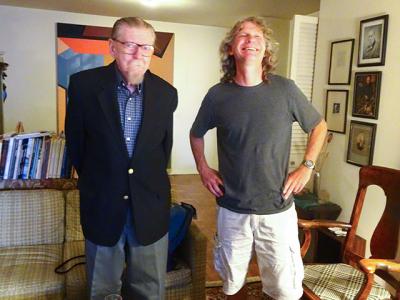A Gimlet-Eyed Goodbye to a Pollock Guardian

While few shed tears at the Francis V. O’Connor memorial symposium on April 12, there was respect and some wry affection for a man who seemed to live by the credo it is better to be feared than loved.
In speaking of him, Avis Berman recalled the line “I don’t get headaches, I give them.” An archivist and art historian, she has been working with Mr. O’Connor’s extensive collection of research files and documents, which he had left to various institutions both before and after his death in November at the age of 80.
Mr. O’Connor was a longtime Jackson Pollock scholar and co-author, with Eugene Thaw, of the artist’s catalogue raisonné. Through it and his work after, he is perhaps best known for his fierce protection of Pollock’s oeuvre from the battalions of forgeries that have presented and re-presented themselves with regularity over the years.
According to Helen Harrison, the director of the Pollock-Krasner House and Study Center in Springs, he was not a full or part-time resident of the East End, but a frequent visitor on business related to Pollock. He was also part of a troika of scholars and administrators of Pollock’s legacy that dates back to his dissertation on Pollock in 1965 and his participation in the Museum of Modern Art’s 1967 Pollock retrospective.
The symposium was jointly organized by Ms. Harrison and the Dedalus Foundation in Manhattan, where the event was held.
Speaking for the Pollock-Krasner Foundation in Manhattan, Kerrie Buitrago, its executive vice president and chief operations officer, called Mr. O’Connor a curmudgeon but the foundation’s “true north.” The foundation was established in 1985 through a bequest by Lee Krasner, who died in 1984, to provide grants “to visual artists of established ability.”
Mr. O’Connor was a member of the foundation’s authentication board, which was active from 1990 to 1996 in examining disputed works for possible inclusion in a supplement to the catalogue raisonné. It disbanded after that because it became “a lightning rod for litigation,” according to Ms. Buitrago. He represented the board every time it was sued after a painting’s rejection and won each of the cases through his unshakable faith in connoisseurship and his demonstration that he had “absorbed into memory the form, composition, and colors” of the artist, she said.
This experience gave him his certainty in disavowing paintings such as one Ruth Kligman, the lone survivor of the Pollock car crash, had consistently claimed to be his last. Even as trustees of Kligman’s estate presented forensic evidence pointing to the painting’s authenticity a few years ago, Mr. O’Connor responded, “I don’t think there’s a Pollock expert in world that would look at that painting and agree it was a Pollock.”
With his passing and the deaths of Mr. Thaw in January and Charles C. Bergman, who was the founding chairman and C.E.O. of the foundation, in March, Mr. O’Connor’s prediction that “when we’re gone, all the fake Pollocks will become Pollocks” could soon be tested.
